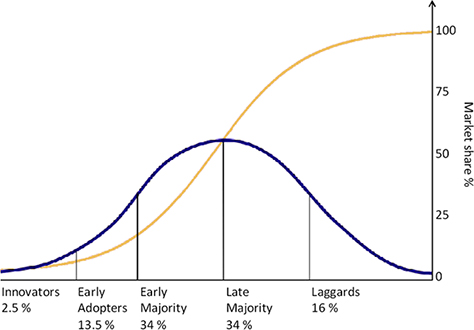The Path of Innovation
Everett Rogers introduced his theory of the diffusion of innovations in 1962. [1] Since that time, his theory has provided guidance to businesses and individual innovators when bringing new technologies to market. The normal path to mainstream success begins with innovators and early adopters, as Figure 1 shows. Innovators are typically people who actually develop new technologies. They plug into the newest technologies as a way of feeding their need to innovate. Early adopters are the first consumers in the market and the test bed for other users. Early adopters are typically itching to try new technology, regardless of the quality of its execution. So they usually acquire new products immediately, just to try them out and determine whether something will be a revolutionary success or an innovative misfire. In this respect, they provide a valuable service.

Right behind the early adopters is a group of users called early mainstream. These users typically pay attention to new technologies, but wait for the market to test them. Following early mainstream users are late mainstream users—that is, people who don’t usually pay a great deal of attention to technology innovations, but eventually adopt new technologies and products once they have become firmly established or even have an overwhelming presence in the marketplace. These users usually come to new products passively.
Finally, there are late adopters, who are people who tend to be suspicious of new technology, don’t see the value of its new capabilities, or don’t feel capable of engaging with new products because of their lack of experience with technology. Older users are a classic example of late adopters, but this group also tends to include people who live in rural or isolated areas and adult users who earn less than $55K annually.
Throughout each of these steps in the adoption curve, social influences tend to play a major role. Early mainstream users hear about new products and technologies from early adopters. Late mainstream users get introduced to new technologies by their early mainstream friends. When late adopters do take up new technology, it’s typically pushed on them by a more tech-savvy friend or family member—someone they trust who influences them directly.
The Problem
Trust and direct social influence are powerful forces that can be quite difficult to replicate. In directly targeting late adopters with new products, companies would be skipping ahead in the adoption process, which presents a series of difficult challenges.
One of these challenges is reaching these users in the first place. Many late adopters do not regularly use computers to access the Internet, so common startup marketing strategies such as social media and online advertising do little to build awareness in the target audience. Late adopters typically still have stronger ties to traditional media such as television and print, with their much higher advertising costs, reduced exposure, and fewer measures of advertising effectiveness. Large corporations can tackle this challenge, because they have greater resources at their command, but startups often have difficulty generating awareness of products that target late adopters.
The attitudes of late adopters toward technology present other challenges these companies must overcome, because it’s not uncommon for late adopters to feel suspicious of new technology or think that most new technology is unnecessary.
Substantial experience with technology that has enriched their lives motivates early adopters to try new technology products. However, late adopters tend to lack the behavioral precedent of successfully adopting innovations, so the idea can be somewhat alien and uncomfortable to them. Establishing demand for a new technology among late adopters requires their embracing new behavior, so involves much more than just introducing the technology to the market, making its adoption much more difficult.
The process of designing products for late adopters also presents challenges, because of the perspective gap that exists between the innovators who create such products and late adopters. It can be very difficult for product designers and developers to relate to users who are on the opposite end of the adoption curve. As a result, they could develop something they think is relatively simple, but is still too complex for inexperienced users. They might also employ user-interface design conventions they think are fairly standard, but might be completely alien to a late adopter who lacks similar experience interacting with the Web or consumer electronics. Many of the interaction design standards that we use today are not necessarily truly intuitive; they have just been around for so long that most people accept them. Interaction design concepts as fundamental as the desktop and windows are metaphors for physical items that may not be immediately clear to inexperienced users. Figure 2 shows a video clip from the film Cloudy with a Chance of Meatballs that demonstrates this gap in a humorous way.
 from Cloudy with a Chance of Meatballs
from Cloudy with a Chance of Meatballs
